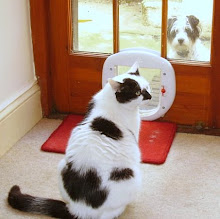In March edition of Cornwall Today - if you can get hold of a copy, RT's pictures are wonderful.
A walk in Betjeman country taking in “one of the best beaches in the world”!
My summer holidays as a child were always spent in Polzeath, round the corner from Daymer Bay, so this area of North Cornwall has special memories for me. Hours spent surfing (bellyboards in my day) before tucking hungrily into steaming pasties. Lying in bed feeling full of salty air, while the Atlantic rollers rumbled comfortingly outside our window.
Fast forward to the present day, and my husband, Mollie dog and I arrived in Wadebridge on a dull Sunday morning, and took the B3314 signposted to Rock and Polzeath. Several miles on we turned left to Rock and Pityme, and just past the Pityme Inn was a small turning on the right to Polzeath. We took this road and after about a mile saw a dusty sign on the left for Daymer Bay. This lane is steep and narrow and leads down to a public car park at Daymer Bay where the shop was shut but the public toilets were open.
Leaving husband behind, Mollie and I walked back up the lane a few yards and turned right, down a private road signposted Footpath to St Enodoc Church. There are large houses on either side, one of which was owned by John Betjeman, who spent many happy times here. Today we passed several cheery dog walkers and emerged onto the windswept golf course of St Enodoc.
I'd been assured that the path was easy to follow - “just follow the white painted stones”. I didn't see many white stones, but stayed on the path and came to the tiny church of St Enodoc, the last resting place of John Betjeman, and also of Fleur Lombard, the first female firefighter to die on duty in peacetime Britain.
The tiny Norman church, with its wonderfully crooked spire, was buried in the sand dunes for many years and the vicar had to be lowered into the church through a skylight to take the annual service. In 1863 the Reverend Hart Smith started to restore this "sinkininny” church and it is still without electricity, but much loved both as a worship place and a shrine for Betjeman followers.
This Sunday the door was beautifully decorated with holly, and a pot of rosemary stood on one side of the entrance; a pot of white heather on the other side. A notice told me that the church was open from 0730 to dusk, so I stepped inside, to be greeted with bouquets of pungent lilies at the door. This tiny church, cradled in a sand dune and surrounded by tamarisk trees, is a peaceful oasis in the desert of modern life.
Back on the golf course, I found more white stones that guided me round the side of the greens, with an overgrown valley and stream to our right; presumably the same stream that Betjeman dammed as a boy while acting as a grudging caddy for his father.
To our left a couple of golfers eyed Mollie suspiciously, but to my relief she behaved herself, and we followed a sign to our left, over a bridge built “in memory of Tom Regis”. As we approached, I noticed a flowering purple hyacinth. A tribute to Tom, perhaps?
From here we followed more white painted stones over the undulating greens, and headed towards the sand dunes. “Over there, love!” cried more golfers, and pointed me in the direction of St Enodoc club house. The skies were heavy with banks of grey cloud, and a lone seagull hovered above us, before moving on.
At this point my husband rang (he's not a walker) to say he was waiting for me in the Rock Inn. Brightening at the thought of a drink half way round, I strode on, reaching a narrow path that brought back childhood memories of sandy walks down to the beach, where we sat and ate Kelly's ice cream, a rich golden treat.
This path led to the golf club car park, and down the hill into Rock, so I rang my husband for directions to the pub. No reply. I turned to the left and found a pub, but the wrong one. I retraced my steps, rang husband again; still no reply. I kept walking – and phoning - and finally saw the Rock Inn on my right.
My husband was sitting upstairs, unaware of an irate wife and his phone ringing in his pocket. Dodging my insults, he bought me a drink and a packet of crisps and wisely kept quiet while I drank in the view. Outside the window the slate green Camel Estuary was sprinkled with empty moorings like hundreds and thousands. Padstow sprawled opposite, with Prideaux Place behind, and the Rock to Padstow passenger ferry trundled back and forth.
Humour restored, Mollie and I walked on to the Quarry car park (more public toilets here if you need them) and walked back along the path that meanders through the sand dunes. If the tide is out, you can walk back along the beach but make sure of tide times: this is a particularly treacherous part of the coast. We stumbled over knotted roots rubbed bare by countless feet, and passed winter hawthorn that looked as if it had been sprayed with golden lichen. A family walked ahead in noisy single file, each wearing a bobble hat of different colours, while on a strip of beach opposite, a lone dog walker chased his dog in and out of the surf.
Over to our left was Harbour Cove and Hawker's Cove and further on, Stepper Point and the lookout station. Doom Bar was clearly visible over the Camel Estuary, with waves rippling on the sandbank. According to legend, this was the curse of a mermaid shot by a sailor: shortly after her death a great storm threw up the sandbank and wrecked many ships in the harbour. Doom Bar has wrecked over 600 ships since records began 200 years ago.
Grateful we weren't at sea, we walked round the headland and below us was the wide expanse of Daymer Bay, freshly washed by the outgoing tide. While Mollie ran headlong along the chamois leather coloured sand, I followed at a more sedate pace, relieved that the bay hadn't changed since my childhood. No wonder the Sunday Times featured this as one of the six best beaches in the world: it's perfect for small children playing on the beach but equally good for surfing and water sports. As Betjeman recalled in “Summoned by Bells”, I remembered the summer warmth of rock pools, the fine sand between my toes and that giddy sense of holiday freedom.
FACTBOX
OS Explorer Map 106 Newquay and Padstow
Walk: 3 miles
Length: 1 ½ – 2 hours
Grade: easy walking but can be steep over the sand dunes
Car park and public toilets at Daymer Bay and Quarry car park, Rock
Refreshments: Cafe at Daymer Bay summer only; cafe and pubs at Rock
Passenger ferry from Rock to Padstow below the Rock Inn, near Quarry car park
John Betjeman spent much of his holidays at Daymer Bay and is buried at St Enodoc Church
Golf courses at St Enodoc and Roserrow
Wheelchair access to coastal path at Daymer Bay
Excellent water sports from both beaches
Camel Estuary is a haven for birds and wildlife
The Camel Trail winds from Padstow through Wadebridge and on towards Bodmin for 17 miles.
Friday, 6 March 2009
Subscribe to:
Post Comments (Atom)
















9 comments:
What a fascinating walk, I'd love to see that little Norman Church, St Enodoc.
St Enodoc is well worth a look, Debs. The pub isnt bad either!!
I love the placenames in Cornwall, it sounds like a foreign language! I was walking right along with you there Flowerpot. :)
Glad you enjoyed it Ak!
No bellyboarding? It's lovely to follow your walks as you obviously enjoy them so much. Glad Himself placated you quickly! I always wonder what Mollie's thinking as she toddles off on a new path.
I love reading about your walks, and always wish I was with you. We would have so much to talk about.
I would love to see that Norman Church.I enjoyed this post
Cheers!
Chris - I think Moll's probably thinking about FOOD or perhaps just aonther lovely SMELL!!
Ellee - we would indeed. Maybe one day...
Susan - good to meet you and please call again. The church is so beautiful...
Post a Comment